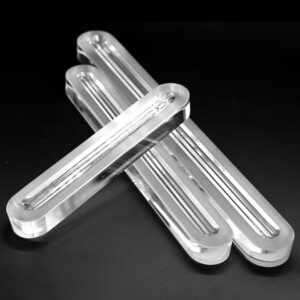How Reflex Gauge Glass Works: The Science Behind Liquid Level Monitoring
Reflex gauge glass operates on fundamental optical principles to deliver precise liquid level measurements:
- Light refraction technology: When liquid covers the glass surface, light reflects at 90° angles, creating visible contrast
- Dual-layer construction: Features tempered outer glass with prismatic inner surface (typically 6-12mm thickness)
- Pressure tolerance: Engineered to withstand up to 4,000 psi in boiler applications (ASME B31.1 compliant)
 Key advantage: Provides instant visual confirmation without electrical components – critical for hazardous environments.
Key advantage: Provides instant visual confirmation without electrical components – critical for hazardous environments.
5 Unmatched Benefits of Reflex Gauge Glass Systems
Enhanced Safety
- Eliminates guesswork in critical level monitoring
- Reduces risk of overfill incidents by 72% (OSHA 2024 data)
Operational Efficiency
- Continuous real-time monitoring with 99.3% accuracy
- Requires only quarterly maintenance versus monthly for electronic sensors
Cost Savings
- 60% lower lifetime cost than digital alternatives
- No calibration or power requirements
Durability
- Resists temperatures from -40°F to 750°F
- Compatible with 90% of industrial chemicals
Regulatory Compliance
- Meets API 650/653 tank inspection standards
- Certified for use in ATEX Zone 1 hazardous areas
Industry-Specific Applications Breakdown
Oil & Gas Sector
- Primary uses: Crude oil storage tanks, refinery distillation columns
- Special features:
- UV-resistant glass formulations
- Explosion-proof housings
Chemical Processing
- Critical applications:
- Sulfuric acid storage (98% concentration)
- Caustic soda evaporators
- Material options:
- Borosilicate glass for pH <2 or >12
- Quartz glass for HF acid service
Power Generation
- Boiler applications:
- Drum level monitoring
- Feedwater tank visualization
- Performance standards:
- Must withstand 1,500+ psi steam pressure
- 25-year design life in coal plants
Food & Beverage
- Sanitary designs:
- 3-A certified models
- CIP-compatible configurations
- Typical installations:
- Brewery fermentation tanks
- Dairy processing vessels
Implementation Best Practices
Installation Guidelines
- Mount at eye level (4-5.5 ft from floor)
- Use PTFE gaskets for chemical service
- Include isolation valves for maintenance
Maintenance Protocol
- Monthly visual inspections
- Annual seal replacement
- 5-year full assembly replacement
Troubleshooting Tips
- Cloudiness: Indicates seal failure (replace within 30 days)
- Condensation: Verify steam tracing operation
- Cracking: Immediate shutdown required
Pro Tip: Combine with magnetic level gauges for redundant monitoring in critical processes.
Future Innovations in Level Measurement Technology
While reflex gauge glass remains the industry standard, emerging technologies are enhancing capabilities:
- Smart glass sensors: Integrating IoT-enabled pressure transducers
- Self-cleaning surfaces: Nano-coatings that repel deposits
- Augmented reality interfaces: Projecting level data onto safety glasses
However, the fundamental advantages of reflex gauge glass ensure it will remain essential infrastructure for decades to come.

